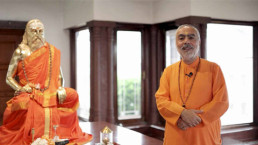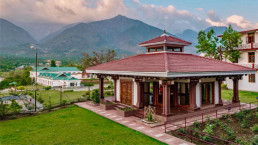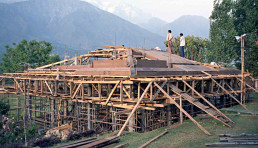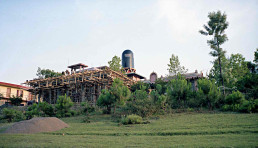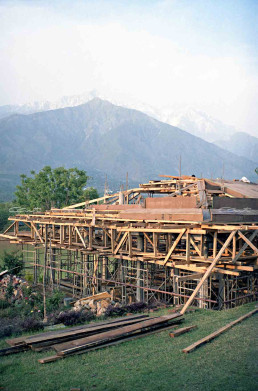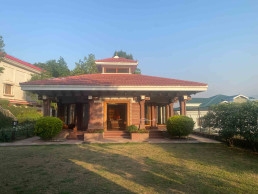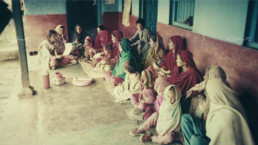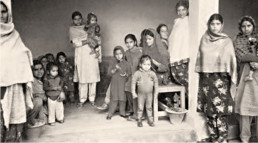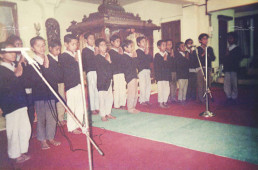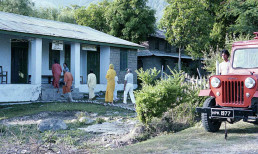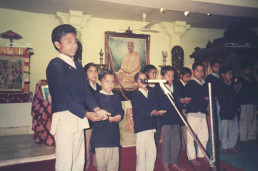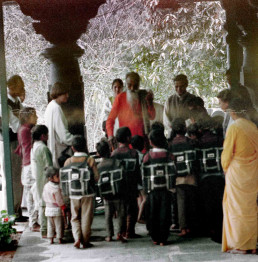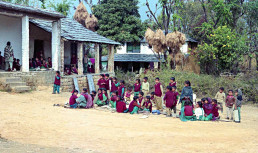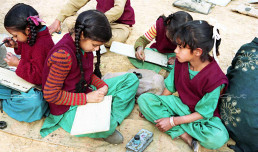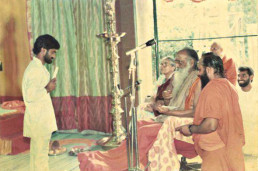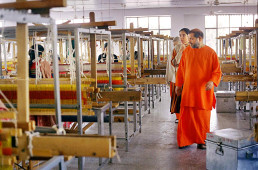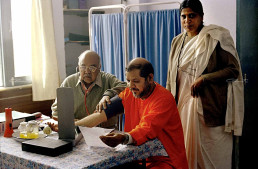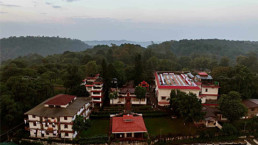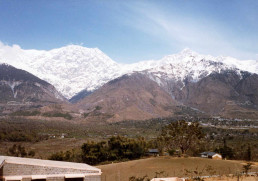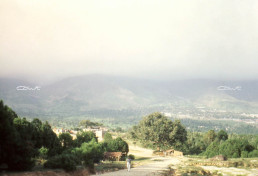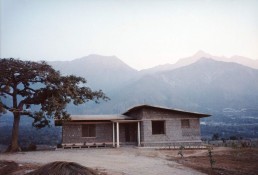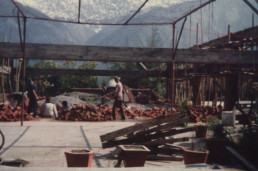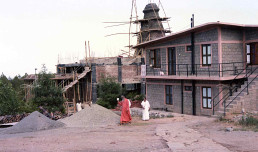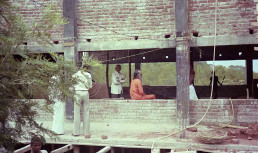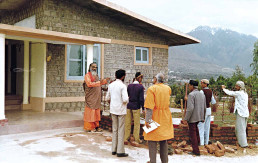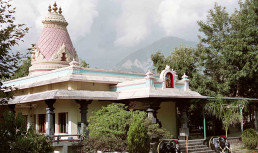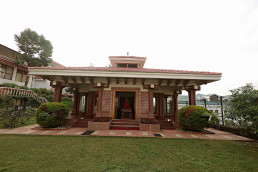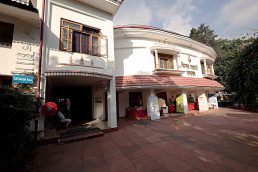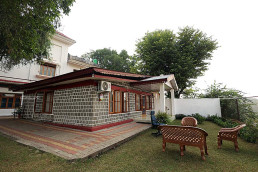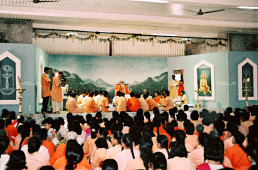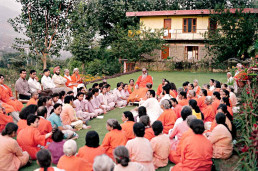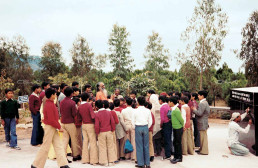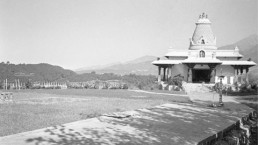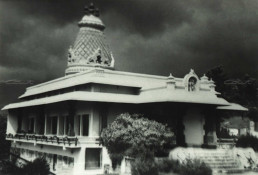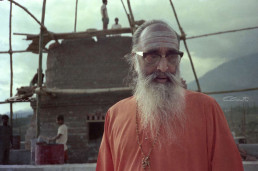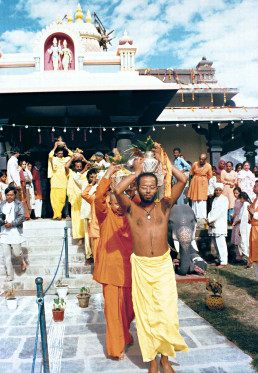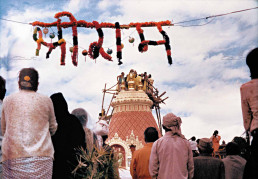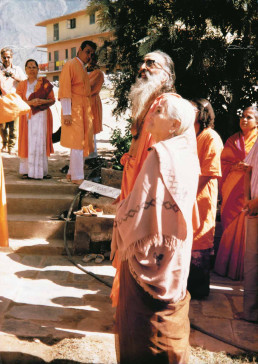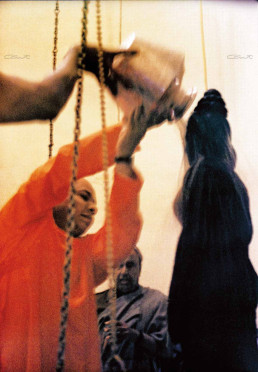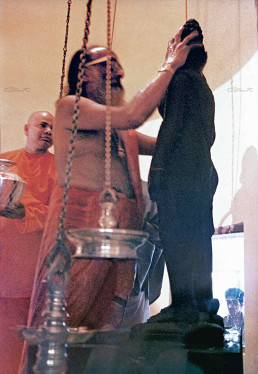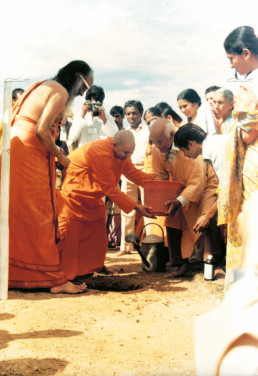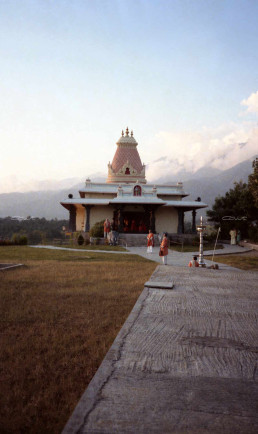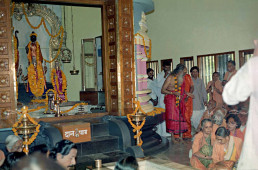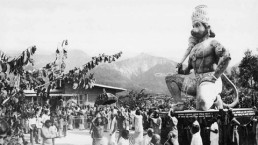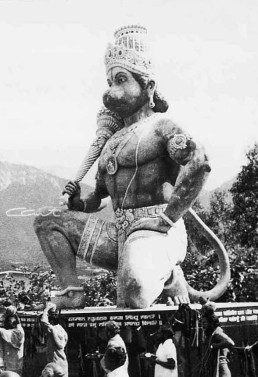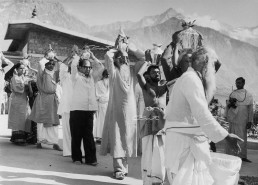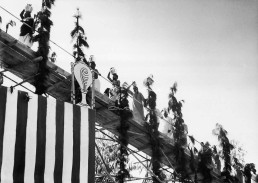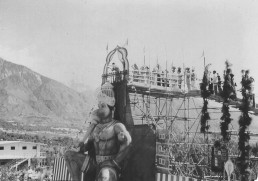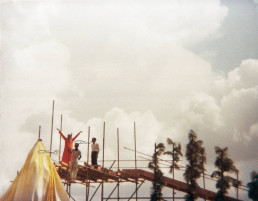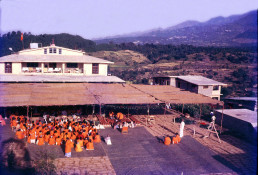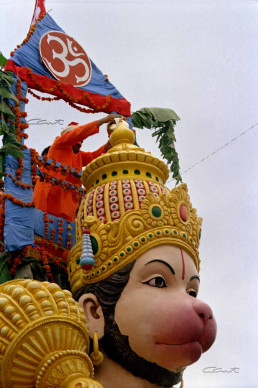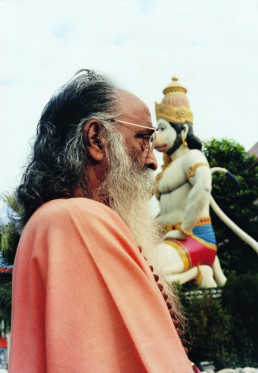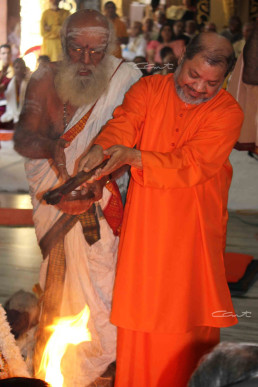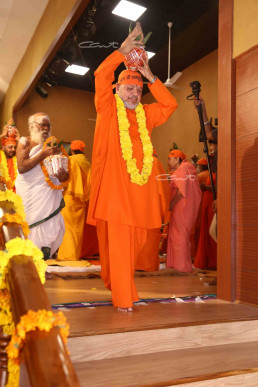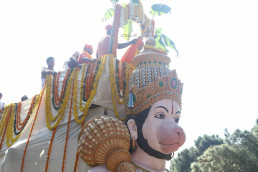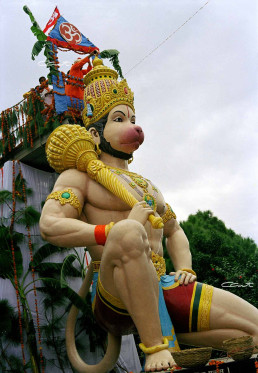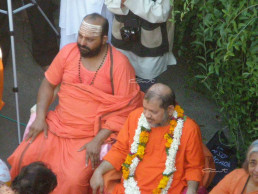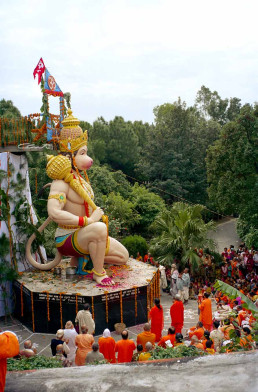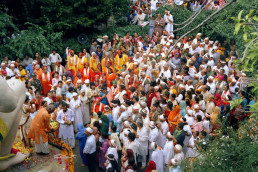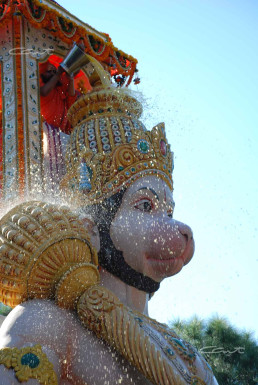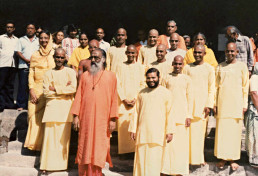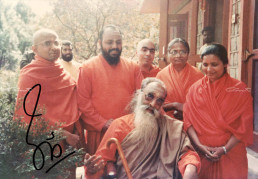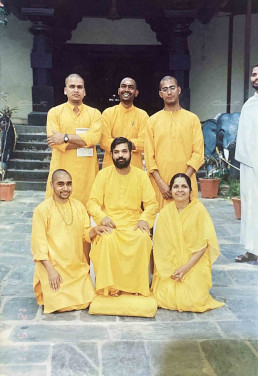Urmila's Transformation

From Troubled Life to Role-Model
Urmila started as a clinic attendant in one of CORD’s subcenters. She was referred by the villagers because of her husband, who would beat her every day after a bout of drinking. He was a poor village carpenter with meager earnings that he splurged entirely on alcohol and other addictive habits. He was also a minor village bootlegger, a gambler, and a womanizer. One night, he even tried to sell Urmila to his drinking mates. That was when she ran away in the middle of the night with her four little children to her inlaws’ home, about five miles away, where she began to stay in a very small room given to her by her in-laws.
She had no money to feed the children. She would earn a little on some days by doing odd jobs in certain homes in the village. Her husband did not leave her alone. He would visit her from time to time. On some days, her husband came home drunk and kicked the food she and her children were about to eat after having been hungry all day and, as usual, beat them all for no reason. Expected to be the traditional bread winner of the family, he did not like the fact that she was the one who was earning some money and feeding the family. In fact, her condition was so desperate that the villagers advised her to live with some other man. Urmila did not want to get into any such type of relationship. Nevertheless, the villagers constantly kept pestering her to enter into such a relationship.
At that juncture, when CORD first met her, she was hiding her face behind her veil, emaciated, unable to utter a word except for an occasional nod. Then, Urmila started working as a clinic attendant on a wage of Rs. 50 per month! She was soon promoted because of her diligence. She was trained as a Village Health Guide by CORD. Her readiness to learn and transfer her health-related knowledge, and her ability to help implement the program with efficiency, enabled her to rapidly grow from a part-time worker (working twice a week for a few hours only) to a fulltime worker. CORD devoted much effort to build her knowledge and skills. Before long, she emerged as an excellent community-development worker and a team leader.
During her work with CORD, Urmila started learning, practicing, and transferring the skills and knowledge to change her own as well as other people’s lives in the community. In her free time, she worked with her growing children to earn extra income from her own microenterprise. She grew mushrooms at home and sold them to make a reasonable profit. Through CORD’s facilitation, she formed, nurtured, and strengthened CBOs of women called Mahila Mandal — Self-Help Groups for Microfinance Access; Adolescent Girls’ Groups; Farmers and Youth Groups; and Children’s Groups.
Urmila then started leading a team of women group facilitators at CORD as a supervisor and later as Chief Community Development Worker. Besides having that role, she herself won people’s confidence in her village through her consistent and persistent selfless work. She won the election and became the ward representative in her Gram Panchayat. She soon began to train others on how to function resourcefully in the Panchayati Raj Institution and promote local self-governance.

With the Guru’s Blessings
Both Urmila’s and Kaushalya’s (see next topic about Kaushalya) children are well settled today, and both of these women have managed to build their small comfortable homes. What they treasure most is their special moments with Gurudev, who gave them love and encouragement, which Guruji now continues to give. Urmila Devi recalls the time when, during a workshop on environment at Solan, Himachal Pradesh, she and her friend Vidya Devi won a cash prize of Rs. 500 in a speech competition about the ‘Environment.’ They were very excited and decided to offer this prize money at the feet of Gurudev. When they were trying with difficulty to reach Gurudev through the crowd of devotees around him, Gurudev noticed them and said loudly to the devotees, “Please give some space so that my people can come to me.” He then introduced them to the crowd, said that they were doing very good work, and blessed them. Later, Gurudev wrote to Urmila a letter which she still treasures today and says, “This is a letter to me from God.” (See the original letter and the typed version below)


Binta Devi's Story
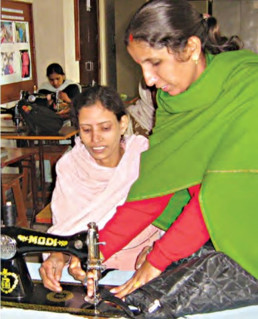
From an Abused Widow to Active Entrepreneur
The following anecdote illustrates, through an individual beneficiary’s story, how the CBOs and the four strategic principles enable CORD to transform the lives of the poor people, who then mutually help each another. Moreover, the story depicts how CORD enriches various aspects of a person as a whole even though the entry point may be through any one of its program components.
Binta Devi became a young widow when her husband, a truck driver, died of HIV/AIDS. Her husband had acquired the disease during his frequent travels to the metropolitan cities. However, her late husband’s family blamed Binta for his death. She and her two children were ostracized by her family. Beaten and kicked out of her original room in the house by her in-laws, shut in a very small dark room where water leaked from the roof, she was physically and verbally abused by her in-laws who, too, were extremely poor. Her children were forced to drop out of school. With no money and nowhere to go, she and her children became malnourished and emaciated. When the local women’s group, called the Mahila Mandal and the Self-Help Group within it (groups which were nurtured by CORD), heard about her condition, they became concerned and brought her to CORD’s clinic. When CORD workers saw her, she weighed only seventy-six pounds. Even her two children were malnourished and scrawny. The three of them looked terrified.
Binta and her two children were referred for HIV testing. Fortunately, all of their test results were negative. With the help of the Mahila Mandal (Women’s Club) in her village that had been promoted by CORD, the field workers from CORD helped Binta get some food from the government’s public distribution system, food to which she was entitled but had not been able to access earlier. The family was counseled by CORD’s informal legal cell team about women’s rights and by the women’s group about the mode of transmission of HIV/AIDS. After a few sessions with the family by the Mahila Mandal and the Panchayat leaders, Binta’s rightful place in the home was ensured by the pressure created by the Mahila Mandal in her village.
The Mahila Mandal in her village then interacted with the school. The school teachers in the small village, out of fear of HIV/AIDS, had forced Binta’s children out of the school. These misinformed teachers were not willing to learn and only acted when some of the members of the women’s groups threatened them by saying, “Give it to us in writing that you will not readmit the children. We will take your statement to the higher education authorities at the block and district levels. Then we will see how the children are not educated in the government school!” Binta’s children, who had been thrown out by the small village school run by the government, were taken back by the school with no further arguments! Subsequently, they all understood their mistake.
Furthermore, the women’s group ensured that Binta became entitled to the widow’s pension of Rs. 330 (about five-six dollars) per month from the government by getting the President of the Panchayat to endorse her application. Though a very small amount, the pension meant much to her. The group enrolled her as one of their members in the Women’s Group as well as in the Self-Help Group (SHG) for access to micro-credit. She learned to save small amounts and get loans from the Self-Help Group and, with that group’s help, from a regular bank without collateral.
Binta’s group motivated her to learn sewing skills. She joined CORD’s sewing training program, where she could earn as she learned. As she learned to stitch garments, she began to take small loans from her SHG to buy raw material to make stitched products. She began to earn a small amount every month. After two years, she began to get enough orders to earn a fair living from this micro-enterprise. She now trains other girls in stitching, charging them a small fee, which adds to her income. Presently, she is an important micro-entrepreneur and member of a Self-Help Group outlet called Guru Dhara Self-Help Group shop run by the women members themselves. Binta and her family now live a dignified, healthy life. Binta’s dream, she says with a broad smile, is to educate her children and build a small home for her family. She earns Rs. 3,000 to Rs. 5,000 per month; with the extra help from the government for food and with an increase in her widow’s pension to Rs. 600, she is now content and happy.
Prostrations
Everywhere in Chinmaya Tapovan Sidhbari, we see His Glory. We see how Pujya Gurudev envisioned the ashram to be a fitting tribute to His Guru, the Glory of Himalayas, Himavat Vibhuti Swami Tapovanam. We realize the glory of the place – Sthala Mahima. And, the Sthala Mahima is because of Shastra Mahima, the glory of Vedantic Knowledge, and Tapo Mahima – the glory of penance. The Sandeepany Gurukula at Chinmaya Tapovan Sidhbari is all Guru Mahima where the blessings of Bhagavan Rama, Bhakta Hanuman, and our Bhakti-Rupa Guru await us.
Whenever we visit Chinmaya Tapovan Sidhbari, we are awestruck by the grand vision of a Yugapurusha like Pujya Gurudev Swami Chinmayananda to conceive and bring to fruition this crest-jewel of the Himalayas at Sidhbari. He who transformed the lives of so many near and far, we wonder how He was driven to do so much so selflessly! The answer is best summarized by Pujya Gurudev Himself:
It is true, that to remain in silence at Sidhbari can be more effective than working. But people like us do not work. They are relentlessly made use of, for fulfilling the Total Vasanas, and IT works through us.
Navigation
Next Topic
Prostrations
Everywhere in Chinmaya Tapovan Sidhbari, we see the Glory (Mahima) of the place, the penance, and the knowledge. The many blessings in the ashram are because…
Home Page
Nothing found.
Previous Topic
Prostrations
Everywhere in Chinmaya Tapovan Sidhbari, we see the Glory (Mahima) of the place, the penance, and the knowledge. The many blessings in the ashram are because…
Samadhi Sthal
The Samadhi Sthal of Pujya Gurudev Swami Chinmayananda (1916-1993) is a hallowed space in the Sidhbari ashram. Pujya Gurudev attained Mahasamadhi at 5:45 pm on August 3rd, 1993, in San Diego, California. After 42 years of teaching the Highest Knowledge, the ageless Guru left the frail body that He had used as the most exalted instrument of Bhagavan.
A hallowed space in Chinmaya Tapovan, the Samadhi Sthal of Pujya Gurudev Swami Chinmayananda (1916-1993) is an inspirational altar in the ashram. It is the sacred place of Pujya Gurudev’s Bhu Samadhi (burial in earth). There, the mortal frame of a much-loved, matchless Guru, one of the greatest teachers of Vedanta, was placed with great reverence in a kund (pit dug inside the earth) on August 9th, 1993, after a dignified and poignant Vedic ceremony.
Pujya Gurudev Swami Chinmayananda attained Mahasamadhi at 5:45 pm on August 3rd, 1993, in Sharp Memorial Hospital, San Diego, California. After 42 years of selfless teaching of the Highest Knowledge, the ageless Guru left His frail body that He used as the most exalted instrument of Bhagavan. When His body was respectfully brought back to Mother Bharat on August 7th, 1993, and laid in state in Chinmaya Mission Lodhi Road Centre, thousands of people paid tearful homage. Seated in a lotus position, Pujya Gurudev’s embalmed body had a radiant aura that can be glimpsed from those last photographs.
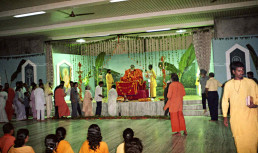
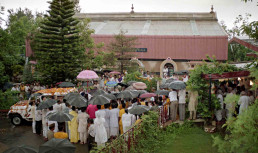
On August 8th, a long convoy brought Pujya Gurudev’s body back to His final resting place in Sidhbari. When His seated body was placed in Kamala Hall for the people of Himalayas and all others to offer their respects, He looked as bright and uplifting as He always did when alive. His favorite japa of “Om Namah Shivaya” surrounded Him as all devotees kept vigil until Pujya Gurudev’s last rites began. It was His wish to rest in the rose garden in front of His Kutiya facing the Dhauladhars that He loved. So, on the night of August 8th, the earth had been dug, 5 feet by 5 feet, 7 feet deep and lined with cement to receive the beloved son of Sidhbari.
In the early hours of August 9th, 1993, after a final darshan to all His beloved devotees, Pujya Gurudev’s body was placed facing the east as the last rites began. All Vedic rituals were performed with great solemnity to befit the Maha Purusha that Pujya Gurudev was. Pujya Gurudev’s body was bathed with Ganga water, milk, honey, ghee, camphor, sandalwood, incense, curds, and other aromatic substances in a last abhishekam performed amid reverential chanting of mantras for two hours. Then, His entire body was interred with salt according to Shastra vidhi, the scriptural injunctions. Starting with the Swamis and brahmacharins, everyone again paid their last respects with a common prayer that Pujya Gurudev’s Grace and blessings shall forever fill their hearts.
With the magnificent Dhauladhar standing guard in the backdrop, the austere Samadhi Sthal is breathtakingly meditative with its elegant combination of woodwork, clear glass, and rosy granite under a Kerala-style tiled roof crowned by a central golden Kalasha.
The structure is built in such a thoughtful manner that it opens up to seamlessly blend with the sylvan surroundings of Sidhbari. Constructed with devotion by Architect Mythili and her team in 1995, it was consecrated in a beautiful, solemn ceremony on Aug.3rd, 1995, by Pujya Guruji Swami Tejomayananda on the sacred occasion of the second anniversary of Pujya Gurudev’s Mahasamadhi day. It is an exquisite shrine among His beloved roses for an inimitable Guru who gloriously embodied the Auspicious Beautiful Truth – Satyam, Shivam, Sundaram – in every breath of His worshipful life.
Inside the Samadhi Sthal, Pujya Gurudev’s Presence is immediate, inspiring, and unmistakably powerful. The brilliant pratima of Pujya Gurudev Swami Chinmayananda is made out of panchadhatu – a combination of gold, silver, copper, zinc, and iron. It was made in Mahabalipuram near Chennai with great prayers. As we gaze at His Pratima, we are filled with a deep yearning to hear His Voice just one more time thundering the message of the Bhagavad Gita, the Upanishads. Almost immediately floods the realization that we can hear Him in our inspired hearts that are made pure with the teachings that He tirelessly illustrated in His every action. We understand that our dearest Pujya Gurudev was more than His physical form which is why He is ever available to every devotee who strives to walk behind Him.
We prostrate at the Lotus Feet of Pujya Gurudev’s Pratima. Overwhelmed with gratitude and reverence, we slip into an indescribable silence. His Grace enters us when our surrender is complete. That is the greatest blessing of Chinmaya Tapovan Sidhbari which we pray for in our lives.
Navigation
Next Topic
Samadhi Sthal
A hallowed space in Chinmaya Tapovan, the Samadhi Sthal of Pujya Gurudev Swami Chinmayananda (1916-1993) is an inspirational altar in the ashram. It is the…
Home Page
Nothing found.
Previous Topic
Samadhi Sthal
A hallowed space in Chinmaya Tapovan, the Samadhi Sthal of Pujya Gurudev Swami Chinmayananda (1916-1993) is an inspirational altar in the ashram. It is the…
Pahadi Upliftment
Pujya Gurudev used to describe true love as a dynamic giving, not a passive taking. One of his main objectives in starting the ashram at Sidhbari was to uplift the lives of the Pahadis, the natives of the Himalayan region who had served the saints and sages in the mountains of yore.
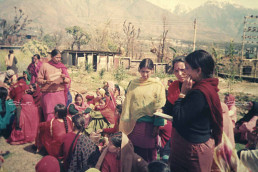
Pujya Gurudev used to describe true love as a dynamic giving, not a passive taking. Such was the exceptional love that He showered on the people of Himalayas, choosing Sidhbari as the place for the Chinmaya Tapovan ashram. So, the founding objectives of the Chinmaya Tapovan Trust was the spread of Vedanta as well as the service of those simple-hearted Pahadis.
Soon after Sandeepany HIM was inaugurated in April 1981, Pujya Gurudev initiated the efforts to serve the Pahadis in March 1982. There were no primary health care centers, and no hospital close enough for medical emergencies. So, Gurudev inaugurated a free medical dispensary, Tapovan Arogya Sadan, where Dr. Indumati Vaidya and Dr. Akhilam (Swamini Nishtananda) served. The manava seva project had struck roots with at least 30 villages benefiting at the very outset.
When Pujya Gurudev understood that women will be benefited most with proper maternal and child health care as multipurpose health workers (community nurses) got trained, He blessed and inaugurated the Chinmaya Rural Primary Health Care and Training Centre (CRPHC&TC) on April 10th, 1985.
“The people of the Himalayas, especially women, have selflessly served the wandering sadhus. This will be our repayment of ṛṣiṛiṅ (debt) to them. I want to serve them.” – Pujya Gurudev Swami Chinmayananda
The reach of the project grew by leaps and bounds as remote areas of Kangra Valley finally got medical help through six outreach health sub-centers. As more trainees became health workers, birth attendants, or village health guides, the need arose for a separate building which was completed in late 1986. The dispensary in the ashram was merged into the project.
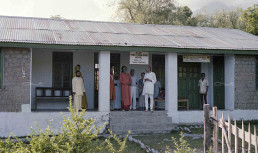
As the project grew, Dr. Kshama Metre came in November 1985, closing her pediatric practice in Delhi for good. After her magical, transformational meeting with Pujya Gurudev, she found both her Guru and her greatest calling at the same time in Sidhbari!
Chinmaya Tapovan Trust strengthened the project with the help of many ashramites. Sri Trilokinath, General Manager of CTT until 1994, assisted in the early years. The commitment of 75-year old Dr. Jayanti Mahimutra as the first director of CRPHC&TC was continued by Dr. Ramakrishna Sharma, retired Deputy Director of Health Services, Himachal Pradesh. Then, Sri K.R. Pai (Swami Ramananda) took over the project until Dr. Kshama Metre became the project director in 1987.
Pujya Gurudev’s guidance was like a mother’s care – gentle, patient, and nourishing. He emphasized on spirituality and character-building for seva to be effective.
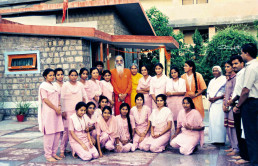
What started with maternal and child healthcare soon diversified to address the poverty, lack of education and livelihood resources, and poor awareness of hygiene, sanitation, and more. Thus evolved the acclaimed CORD – the Chinmaya Organisation for Rural Development. The empowered women became a driving force with their Mahila Mandals. CORD also motivated, mobilized, and enabled powerful community-based organizations, CBOs. The success that started in Sidhbari became a CORD saga which continues to empower not just the Pahadis but so many more across rural India.
In Sidhbari, Pujya Gurudev started a silent revolution with an expanding influence. While the rural women were learning the art of collective action and active participation, Pujya Gurudev turned His attention to the Pahadi children and youth. The Hari Hara vocational schools focused on children learning through field experiences and then getting trained in various vocations that would enrich them.
Sri Hansraj who came to Chinmaya Tapovan ashram as a youth speaks with affectionate reverence about the way his life was transformed by the Grace of Gurudev. In his words, we can hear gratitude for how Pujya Gurudev brought hope, confidence, and prosperity to the Pahadis.
Three Examples of Transformation
The following anecdotes illustrate, through an individual beneficiary’s story, how the CBOs and the four strategic principles enable CORD to transform the lives of the poor people who then mutually help each another. Moreover, the stories depict how CORD enriches various aspects of a person as a whole even though the entry point may be through any one of its program components. These excerpts are from the Mananam publication titled "Chinmaya Seva."
Nothing found.
Nothing found.
Pahadi Upliftment Videos
Navigation
Next Topic
Pahadi Upliftment
Pujya Gurudev used to describe true love as a dynamic giving, not a passive taking. One of his main objectives in starting the ashram at Sidhbari was to uplift…
Home Page
Nothing found.
Previous Topic
Pahadi Upliftment
Pujya Gurudev used to describe true love as a dynamic giving, not a passive taking. One of his main objectives in starting the ashram at Sidhbari was to uplift…
The Progress at Sidhbari
When we visit Sidhbari today, it is hard to imagine the unapproachable land that it was in the 1970s. Swami Chinmayananda’s vision made that metamorphosis in the mountains happen. The way the ashram has grown with the wholehearted teamwork of devotees reflects the purity and power of Pujya Gurudev’s sankalpa. Year after year, new buildings and facilities were added.

When we visit Chinmaya Tapovan Sidhbari today, it is hard to imagine the barren, unapproachable land that it was in the 1970s. Pujya Gurudev’s vision made that metamorphosis in the mountains happen. And the way the ashram has grown with the diligent, wholehearted teamwork of devotees of all backgrounds and talents reflects the purity and power of Pujya Gurudev’s sankalpa. Pujya Gurudev embedded in the growth many remarkable memories and lessons for all of us.
All the ventures undertaken, from the divine landmarks to the accommodating facilities and amenities, brick by brick on the outside and thought by thought on the inside, were centered around spiritual evolution for all who stepped into the Sidhbari ashram.

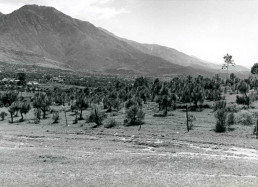
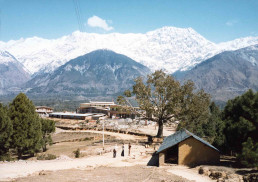
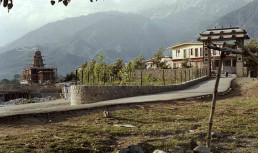
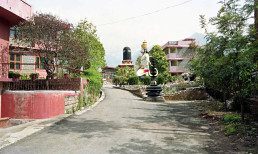
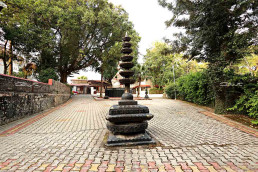
So much thought went into making the ashram self-sufficient. The nourishing touch of Pujya Gurudev was evident when the goshala, the cowshed, was set up in March 1989. Early days in Sidhbari meant tea with tinned milk powder. But that changed when the goshala with the cows and their tinkling bells became part of the ashram. Now fresh milk and the soothing moos of cows add to the sweet, serene joy inside Chinmaya Tapovan.
The newer buildings in Chinmaya Tapovan ashram are embellishing its ancient spiritual objectives.The new auditorium, Chinmaya Shatabdi Sabhaghar, built in the centenary year 2016 with a capacity to seat 670 people, resounds with the joy of many auspicious pujas and celebrations. Its open terrace where the Sidhbari skies glide over the meditative Dhauladhar mountain peaks unfolds the power of collective prayers during the blissful Vishnu Sahasranama Pujas.


The striking transformation in Sidhbari through the years is not just from new buildings and landmarks. The landscaping of the ashram and temple surroundings was done with aesthetic acumen by Pujya Gurudev. He gave clear instructions to Sri H.K. Madhwal, a retired forest officer, outlining the overall plan for the trees, the garden, the hedges and grass. In subsequent letters he writes: The idea of tree planting is sacred. Why not get a teak, a rose wood and a Chandan plant? Try these Brazilian Papaya seeds near the dining hall. Make seedling and then replant each.”
From the barren landscape to the green hermitage that it is now, the lush vegetation was nourished with great love and care by Sri. Madhwal after Vayuputra Veera Hanuman calmed the winds. It is wondrous to find an international mix of foliage – the California redwoods amid the deodars, camphor plants, African bamboo, and Australian eucalyptus. There is a vitalizing fragrance of a variety of exotic blooms of jasmine, lilies, champa, chrysanthemums, gardenias, and of course, the beautiful roses that Gurudev loved.
Chinmaya Tapovan is a spiritual nandavana where the splendor of Nature is undisturbed by the progress planned with care.
A list of buildings and the year of construction
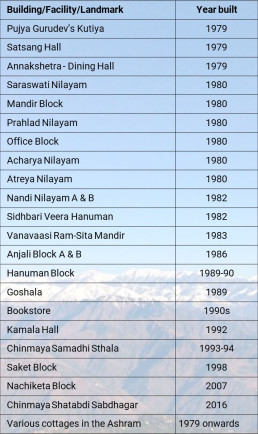

Aerial view of the land at Sidhbari
Navigation
Next Topic
The Progress at Sidhbari
When we visit Sidhbari today, it is hard to imagine the unapproachable land that it was in the 1970s. Swami Chinmayananda’s vision made that metamorphosis in…
Home Page
Nothing found.
Previous Topic
The Progress at Sidhbari
When we visit Sidhbari today, it is hard to imagine the unapproachable land that it was in the 1970s. Swami Chinmayananda’s vision made that metamorphosis in…
Spiritual Camps
Sidhbari is synonymous with Pujya Gurudev’s unforgettable spiritual camps. Pujya Gurudev would say: “It is absolutely necessary for spiritual Sadhaks to dry-dock to a quiet place like Sidhbari and listen to the spiritual Masters, deeply reflect on them, and lift the mind in contemplation on the Reality.”
The life force in Chinmaya Tapovan ashram is Vedanta. While Sandeepany HIM is the site for the two and a half years full-time Vedanta courses for enrolled students, Pujya Gurudev opened up the gates of the Sidhbari ashram to share the inspiring scriptures with people from all walks of life. So, Sidhbari is synonymous with the unforgettable camps that Pujya Gurudev first started which the Chinmaya Guru Paramapara continues.
In 1981, the inaugural year of the ashram, Pujya Gurudev invited the world to experience the bliss of the first camp at Sidhbari with Vivekachoodamani, the poetic Vedantic composition of Bhagavan Adi Shankaracharya. From Sep.4th – Oct.28th, 1981, Pujya Gurudev taught the exquisite text of 581 verses in five historic camps where he took the blessed audience to the enthralling heights of Vedanta.
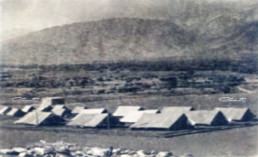



It was the time when Sidhbari was hardly known, and the amenities in the ashram were the bare essentials. There were hardly any cottages or even beds. Yet, the sheer power of Gurudev’s discourses and the exalted subject matter swept everyone off their feet into a realm beyond physical wants.
Those first five camps were a magical penance with a routine that reined in the wandering senses and redefined time. Pujya Gurudev encouraged all to use the spiritual retreat as a time to embark on a single-pointed quest for the Highest. It was a time for temporary sannyas – to renounce the noisy wants of the world and step into the silence of the Self.
The 5 am meditation sessions with Gurudev were blissful. The eloquent brilliance of Gurudev’s examples in his daily discourses at 6:30 am and 7:30 pm had the audience spellbound. Gurudev directed delegates to walk in solitude through the pine forest for some time in the day to introspect in deep silence. The discussions and question-answer sessions with Brahmachari Vivek Chaitanya, the first Acharya of Sandeepany Himalayas, increased understanding. The evening satsangs in the ethereal dusk of Sidhbari uplifted all to the peaks of reflective stillness.
While the intellect was steered toward clarity, the heart was softened to experience the purity of devotion. The collective Vishnu Sahasranama Archana and the trip to the stream to offer the flower petals after the puja made hearts soar and sing with divine joy. The Paada pujas offered to Pujya Gurudev’s holy Feet were full of reverence.
The fragrance of knowledge and devotion also came through in the routine of those camps when all attendees could assist and volunteer in different ways during the days.
There were other special events that made these early camps stand out even more. The Dalai Lama visited Chinmaya Tapovan for a special satsang on October 3rd, 1981 during the third camp.
Oct.27th, 1981, during the fifth camp, Pujya Gurudev consecrated the very special idols of Sri Kirata Murti Shiva and Parvati along with Lord Ganesha in an intricately carved Mandap inside the Satsang Hall. He narrated the story of Arjuna being blessed with the Pashupataastra after Shiva, in a hunter’s guise, tested and wiped out Arjuna’s arrogance. Arjuna learned the importance of humility and complete surrender.
Even today, those reigning idols inside the Satsang Hall are Pujya Gurudev’s reminder to us about the importance of surrendering our vasanas during satsang.
When the final camp of the first Vivekachoodamani series concluded on Oct.28th, 1981, Gurudev conducted the landmark convocation ceremony, a tradition he had started since the first camp. Pujya Gurudev applied the chandana tilaka to bless each attendee and gave a certificate to recognize the completion of the verses in that session. Then, each attendee carried a lamp lit from the Akhanda Jyoti at Swami Tapovan Maharaj’s altar and placed it on their home-states on a map of Bharat. With that unique ritual, Pujya Gurudev emphasized the importance of each seeker spreading the light of knowledge in their hometowns.
Pujya Gurudev conducted about 43 camps in Sidhbari expounding on a vast range of introductory and Upanishadic texts. In several of the camps, Brahmachari Vivek Chaitanya melted hearts with his discourses on Tulsi Ramayana, sweetening the flowing Knowledge with nectarine devotion.
After those iconic camps of 1981, the flow of Knowledge, Jnana Ganga, from Sidhbari was incessant. Pujya Gurudev called the spiritual camps as a port for spiritual dry-docking. He said: “‘You all have come here for dry-docking, It is a must for spiritual Sadhaks. The ships, after a few voyages in the ocean, are dry-docked for a complete rehauling and repairs. It is absolutely necessary for spiritual Sadhaks to dry-dock to a quiet place like Siddhabari and listen to the spiritual Masters, deeply reflect on them and lift the mind in contemplation on the Reality. This constant listening, thinking and contemplating helps the corroded mind to drop all its dross that it gathered during its sojourn in the ocean of Samsaar. A mind thus repaired and properly tuned up, can expand and lift itself to a state of Pure Awareness and Bliss.”
Chinmaya Tapovan Sidhbari is truly a vibrant spiritual port. Throughout the years, many Swamis and Acharyas ferry their devotees from all over the world to ‘dock’ in the soothing serenity of Sidhbari. Spiritual camps in Hindi, English, and the regional Indian languages are conducted regularly, and the camp routine that Pujya Gurudev initiated is still implemented. Meditation, daily discourses, discussions, Q&A sessions, seva opportunities, bhajans, and the famous treks in the pine forests are key attractions. Pujya Gurudev’s Paduka Puja is a worshipful experience. And, the field trips to the Gaushala and CORD premises are cherished by all.
The camps also reach out to a varied audience. Chinmaya Tapovan Trust graciously hosts yearly CHYK camps, management camps, educational trips from Chinmaya Vidyalayas and colleges. The complete experience in Sidhbari is an uplifting, continuous blessing.
Spiritual Camp Videos
Camp attendees placed lamps on their home states after camps in the early years.
Paada Puja offered by the sisters of Pujya Gurudev
Pujya Gurudev used to distribute Prasada in a loving way after Paada puja.
Pujya Gurudev's powerful explanation of Sat-Chit-Ananda during a camp in Sidhbari
Pujya Gurudev enjoying a Malayalam bhajan before a bhiksha in Sidhbari
Pujya Gurudev enjoying a Pahadi bhajan
Navigation
Next Topic
Spiritual Camps
Sidhbari is synonymous with Pujya Gurudev’s unforgettable spiritual camps. He would say: "It is absolutely necessary for spiritual Sadhaks to dry-dock to a…
Home Page
Nothing found.
Previous Topic
Spiritual Camps
Sidhbari is synonymous with Pujya Gurudev’s unforgettable spiritual camps. He would say: "It is absolutely necessary for spiritual Sadhaks to dry-dock to a…
Ram Mandir
The presence of a devotee draws the Lord without fail. Pujya Gurudev carefully planned the location of the Ram Mandir such that the eyes of Sidhbari Veera Hanumanji could forever gaze at the Lotus Feet of Bhagavan Rama.

The first Hanuman Mastakabhishekam completed on Oct.10th, 1982, showered the funds to lay the foundation for a unique temple – the first temple for Sri Rama and His Consort Sita in the Himachal land where, though Tulsi Ramayana was revered, most temples were for Devi or Shakti.
On March 6th, 1983, during the Bhoomi puja, Pujya Gurudev remarked that the temple would be a Setu, bridging the cultures of North and South. And, the idols to adorn the temple were Vanavaasi Rama and Sita – their austerely beautiful forms during their exiled 14-year forest life. The idols were carved from soft black stone by a famous sculptor Sri B. Basavanna of Mysore.
While explaining the significance of the Vedic rituals after the Bhoomi Puja, as the divine idols of Sri Rama and Maata Sita were unveiled, Pujya Gurudev, with His typical humour, pointed out that “Lakshmana had gone to collect fruits!” Maybe Pujya Gurudev wanted us to remember that Lakshmana-like Vairagya must be in our hearts in a life of Tapas and Bhakti.
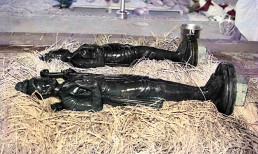
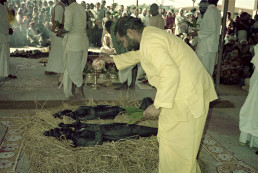
The Dhaanya Adhivaasa ritual on March 6th, 1983, was highly significant. The exquisite idols of Sri Rama Sita gracefully placed on a bed of grains to await installation were a heavenly sight. When people offered grains and even silver coins to the idols, Pujya Gurudev emphasized the importance of surrender, both spiritual and material.
A rare aspect of the Vanavaasi Ram Mandir is how the main altar of the temple is truly and literally founded on intense worldwide prayers. In response to Gurudev’s call for a Likhita Japa Yajna, 7844 devotees from 24 countries wrote “Om Sri Ram Jaya Ram Jaya Jaya Ram.” The total count of the written Japa was 28,84,875 when they were reverentially placed in the enclosure below the inner shrine.
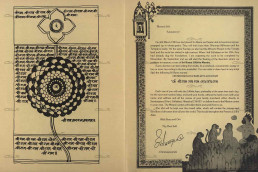
Pujya Gurudev carefully planned the location of the Ramaalaya such that the eyes of Sidhbari Veera Hanumanji could forever rest at the Lotus Feet of His beloved Lord Rama. And, Pujya Gurudev emphasized how the ‘Kurma’ placed in the threshold of Sri Ram Mandir reminds devotees to withdraw all wandering senses for a fulfilling darshan of Bhagavan Rama.
The Mandir construction was completed in a record six months. Pujya Gurudev once remarked that “Hanumanji Himself was literally building the temple!” The entire Mandir is an aesthetic masterpiece of sacred beauty and symbolism.
In the video excerpts below, Sri Hemachandrudu of Lakshmi Constructions, Chennai, recalls the large-hearted love of Pujya Gurudev when credits were given for the temple construction.
The Kumbhabhishekam of the Vanavaasi Ram Mandir was a momentous three-day celebration with notable events. Oct.21st, 1983, began with Pujya Gurudev initiating a great blessing to Chinmaya Mission’s future. In a special diksha ceremony, Brni Yamuna Devi became Swamini Gangananda and Br. Radhakrishnan became Swami Jyotirmayananda. Br. Vivek Chaitanya, the first acharya of Sandeepany Himalayas was given sannyasa diksha to become the beloved Pujya Guruji Swami Tejomayananda, the global head of Chinmaya Mission from 1993 to 2016.
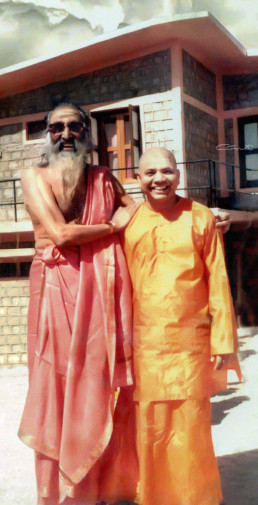
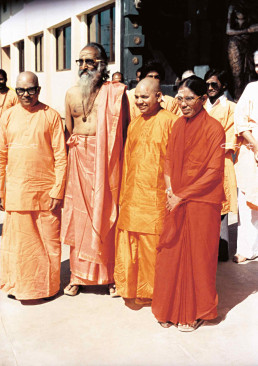
The whole atmosphere of Chinmaya Tapovan ashram was surcharged with spiritual vibrations on Oct.22nd when the newly initiated Swamis performed Kumbhabhishekam amid akhanda chanting of “Om Rama Ramaya Namah,” preliminary homa, pujas, archanas, and a Kalasha procession – all conducted flawlessly in Vedic style which filled the hearts of everyone.
Later on, when Pujya Gurudev performed Prana Pratishta to invoke Bhagavan’s Presence in the idols within the temple, the faces of Vanavaasi Rama Sita shone with a divine glow.
The consecration continued on Oct.23rd with the installation of Lord Ganesha and the Utsava Murtis – the idols of Ram Parivar.
Rare is the opportunity to witness a temple’s consecration. The devotees in Sidhbari, from the Governor of Himachal Pradesh to the simple Pahadi villager, were overjoyed by the grand celebrations of the Maha Kumbhabhisekham.
Today, as we prostrate inside that incomparable Vanavaasi Ram Sita Mandir in Sidhbari, we realize that here is an auspicious sanctum where Pujya Gurudev showed us the joy of penance, purity, deep faith, and devoted work.
From Veera Hanuman to Sri Ram - A panoramic view
Ram Mandir Videos
A glimpse of the Likhita Japa books which were later placed under the altar
Pujya Gurudev does Prana Pratishta for the newly installed idols.
Navigation
Next Topic
Ram Mandir
The presence of a devotee draws the Lord without fail. Once Veera Hanuman took up his abode in Sidhbari, His beloved Lord Rama also had to come there.
Home Page
Nothing found.
Previous Topic
Ram Mandir
The presence of a devotee draws the Lord without fail. Once Veera Hanuman took up his abode in Sidhbari, His beloved Lord Rama also had to come there.
Veera Hanuman
With the site for the ashram purchased, the next challenge was the forceful gales of winds and heavy rains. The land was barren as strong winds uprooted vegetation, and heavy rains caused boulders to come hurtling down from the mountains. Slates of rock and piles of sand brought in for construction would be thrown around and blown away overnight. No high-rise building could even be attempted in the windy, high altitude among the mountains and open land. As Pujya Gurudev observed this hurdle, he declared and invoked, “Let Vayuputra Hanuman be here.”
Facts
CONSECRATION
October 10th, 1982
DESIGN
Initial sketch by Pujya Gurudev
Prototype and Sculpture by Shri Kashinath Shilpi
Statue: 16-feet
Granite Base: 6-feet
NOTES
Verses from Tulsi Ramayana selected by Pujya Guruji Swami Tejomayananda adorn the granite base.
Over 5,000 attended the first Mastakabhishekam.
Early photographs
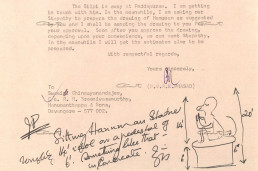
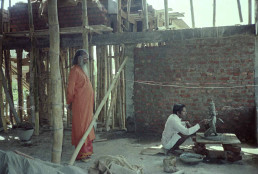
Awe-inspiring, alert, and magnificent, Vayuputra Shri Hanuman is a powerful presence in the Chinmaya ashram at Sidhbari. Calming the gusty winds across an open landscape with His powerful yet compassionate glance, the majestic Lord sits in veerasana ready to serve both Shri Ram whom He holds in His heart and the devotees who adore and approach Him.
It was the vision of Pujya Gurudev Swami Chinmayananda that sketched the arrival of the 22-feet idol of Shri Hanumanji at Sidhbari. Seeing how the fertile land of Sidhbari stood bare because of the strong winds, Pujya Gurudev invoked the Presence of Vayuputra Hanuman. His simple sketch in a letter (1981) to a longtime devotee marked the birth of the 16-feet towering idol atop a 6-feet pedestal. Gurudev knew – where the son will be, the Wind-God father will move with gentle affection! Thus was invited Vayuputra Shri Hanuman to watch over the Sidhbari ashram as construction progressed smoothly.
The son of Wind-God would be gigantic. As the Tejasvi Amshavatara, the son of Lord Shiva born in Mother Anjana’s womb through Vayu as His instrument, the Vayuputra had to be there to serve and support future growth. Though He held His mace (gadha) with powerful grace, He would kneel in devotion, ready to serve His Lord Rama who would arrive in the ashram a few years later! As Hanumanji took form in Sidhbari, the winds grew calmer, and the land rejoiced with lush fertile growth.
Here is a transcript of the interview with Shri Kashinath Shilpi and his crew who came to sculpt the splendid Shri Hanumanji. After the Vayuputra idol was completed and stood victorious in Sidhbari, divinity manifested all around in the structures built. The massive Shivalingam that crowned Pujya Gurudev’s kutiya signaled auspiciousness all around, and the idol of Nandi in front of the kutiya was the ready vehicle for service.
Mastakabhishekam
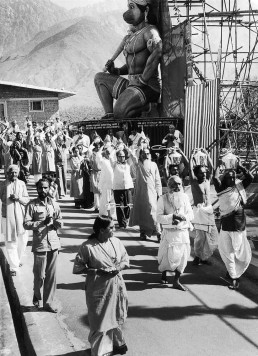
It was important to offer gratitude and worship to the supreme sevak, Sri Pavanaputra Hanuman. So, in 1982, Pujya Gurudev inaugurated the tradition of the once-in-five years Mastakabhishekam in Sidhbari. Mastaka means the head; the ritual of Mastakabhishekam is a consecration ceremony where an idol is bathed from head to feet. Pujya Gurudev wanted the whole of Sidhbari to rejoice and pray as the lustrous 16-ft Hanumanji atop the 6-ft pedestal would be consecrated with Panchamruta Abhishekam from crown to feet. It was a ceremonial bathing of the idol from the Mastaka(head) to toe. The preparations were elaborate and enthusiastic. A ramp over 90 ft long was constructed by the army personnel of the Yol Cantonment; an energetic CHYK contingent from Chennai delighted all with their dedicated seva. Hanuman Chalisa, bhajans and satsangs infused bhakti and Jnana in joyous harmony. A team of learned priests led by Sri Subbarama Sastrigal began the Vedic rites on the evening of October 8, 1982. October 9th was a day of many prayerful homams followed by the Kalasha Staapanam. A thousand and one pots/kalashas assorted in gold, silver, stainless steel, brass, copper and mud were filled with Ganga water, milk, curd, turmeric, or sindoor, and sanctified by pujas, archanas, chanting, and arati. The vibrations divinized the entire surroundings.
When Pujya Gurudev followed the priests and led the procession of devotees and dignitaries with a Kalasha on his head on the morning of October 10th, the devotion, discipline, and dedication of the entire gathering became a worshipful legacy of Chinmaya Tapovan Sidhbari. This was the first time that the people of the Himalayan valleys witnessed and participated in such a grand event. Truly, Pujya Gurudev began a beloved tradition of Sidhbari. The Mastakabhishekam that happens once every five years continues to be an event that brings together the Pahadis and people of all countries to convey their adoring gratitude to the Supreme Sidhbari Hanumanji who epitomizes alert wisdom, divine strength, deep devotion, and the supreme spirit of seva.
As we gaze at Sri Hanumanji’s form seated in the Veerasana pose, ready to serve Bhagavan Rama in His Heart, we realize that Pujya Gurudev embedded, in that magnificent idol, the message of devotion and seva with selfless dedication.
Below is a timeline with key details of the Mastakabhishekams that have continued since 1982.
HISTORY
Every five years, a Mastakabhishekam is performed to Lord Hanuman at Sidhbari. Below is a brief chronicle of this momentous event over time.
In 1982, when Shri K. Kashinath Shilpi had completed the construction of the idol (here is a transcript of the interview with Shri Kashinath), Pujya Gurudev planned the first Mastakabhishekam to consecrate and invoke the power of Lord Hanuman into the beautiful idol seated under the open skies according to Vedic traditions. To perform an abhishekam (the divine bathing ceremony) from the crown to feet of the towering idol that rose about 22 feet, a ramp that extended over 90 feet from the ground to the top was erected by the army personnel of Yol Cantonment. It was decorated by pine tree branches carefully picked with devotion and reverence to Nature. The energetic Chyks from Chennai led by Swami Siddhananda were a great help in this inaugural consecration.
The rituals began on October 8, 1982. As the Vedic vibrations filled the air, Pujya Gurudev guided all devotees to a continued chanting, “Om Sri Ramadhootaya Namaha.” Br. Vivek Chaitanya (now Swami Tejomayananda) added the melody of devotion inspiring them to also sing the Hanuman Chalisa. When lightning and thunderous rains filled the skies two days before the abhishekam, Pujya Gurudev Swami Chinmayananda remarked: Perhaps Varuna and Indra wanted to do the abhishekam first and give their benediction!
October 9 was a pious day of homams and kalasa sthapana. Thousand and one kalasas (pots) in gold, silver, brass, stainless steel, copper, mud filled with either water from Ganga or milk, curd, turmeric or sindhoor were divinized with invocations and worship (Aavaahanam and Sahasra Archana). As those rituals concluded, Sri Hanumanji’s idol was unveiled that evening after Arati.
When October 10th dawned, the Mastakabhishekam drew about five thousand people worldwide, including army personnel, government officers, and joyful people from the villages that surrounded the beautiful Sidhbari. As the priests followed by Pujya Gurudev, dignitaries, and devotees walked up the ramp with the sanctified Kalasas to perform the abhishekam, bathing Lord Hanuman’s form from crown to foot, the entire gathering was immersed in devotion with reverential chanting. Worship (Archana) with adornment (Alankara) and arati culminated with a long vada mala offered to the newly consecrated lustrous Lord; Vayuputra Hanuman stood blessing all of Sidhbari.
That first abhishekam on October 10, 1982, marked the onset of the 5-year tradition surrounding Shri Hanumanji at Sidhbari.
With the holy waters from the Ganga of Haridwar, the Kalasas were anointed as the homam rituals again purified the air to mark the 5-year milestone after the first consecration of the Sidhbari Vayuputra. It was a heartwarming sight to watch Pujya Gurudev Swami Chinmayananda race up the ramp which was built by the local villagers.
Pujya Gurudev led the Abhishekam procession energized by the sonorous chants of “Om Sri Ramadutaya Namaha.” Fireworks lit up the skies as the procession moved from the idol of the greatest Sevak Hanumanji to also perform the Abhishekam of His Master, the Supreme Lord Vanavasi Rama and Mother Sita at the Rama Mandir in Sidhbari.
This was the last Mastakabhishekam performed by Pujya Gurudev before His mahasamadhi in 1993.
Held a day after the memorable Vivekachoodamani camp of Pujya Gurudev, the third Mastakabhishekam was marked by elaborate preparations and excellent support by an earnest group of army personnel from the Yol cantonment who had erected an iron ramp and railing for the abhishekam. A sacred ceremony of Kalasa sthapana was followed by another hallowed reconsecration ceremony that filled hearts with grateful devotion toward the imposing guardian Lord of Sidhbari.
Set inside a beautiful mantap, 390 kalasas were brimming with the holy waters from the Manasarovar to the southern rivers and seas. Vedic scholars from Delhi (led by Sri Subbarama Shastri) initiated the ceremony with elaborate homams and performed puja to those kalasas. Notable were the three Pradhana Kalasas – for Lord Rama, Lord Hanuman, and one honoring Pujya Gurudev Swami Chinmayananda who had attained Mahasamadhi in 1993. When Pujya Guruji Swami Tejomayananda and other acharyas offered abhishekam with the sanctified waters, it was as though Tejasvi Hanuman was beaming down on the hundreds of devotees. As Hanumanji glowed even more in the Arati after vastra (new clothes) and garlands were offered, a gentle rain from the skies seemed to carry the joy of the heavens down to Sidhbari.
The skies over Sidhbari poured in anticipation, two days before the 5th mastakabhishekam in 2002. On the day of the abhishekam, priests carried the three Pradhana Kalasas from Kamala Hall while Pujya Guruji Swami Tejomayananda and the acharyas held the kalasas on their heads and performed the Mastakabhishekam amid devoted, enthusiastic chanting of Om Sri Ramadutaya Namaha. Later, as the face of Shri Hanuman shone in the Arati, the sun smiled between the parting clouds as if joining the celebration to delight all.
After gaining inspiration from Pujya Guruji’s camp on Hanuman Chalisa, the silver jubilee Mastakabhishekam started off melodiously with a musical concert by Pandit Jasraj. Then began the Vedic preparatory rituals of pujas and homams under the leadership of Shri Subbarama Shastri as four Pradhana Kalashas ready to be specially offered to Sri Rama, Lord Shiva, Lord Hanuman, and Pujya Gurudev adorned the top of the pyramid of 1000 kalasas.
Everyone wanted to offer their best to Shri Hanumanji – the Indian Army built a special ramp with much devotion; specialists from Brindavan, at Swamini Gurupriyananda’s request, decorated the place with flowers. When Pujya Guruji led the Mastakabhishekam procession in an atmosphere of fervent chanting and joyful Pahadi Bhajans, Shri Hanumanji’s face reflected the joy of His devotees. The special offerings of garlands, tulsi mala, angavastram, silver anklets, and a gold-embossed red belt with “Sri Ram Jay Ram ” lettered on it added the festive silver touch to the glowing Lord.
Keeping with the Vedic traditions, the 7th reconsecration ceremony was performed with great devotion and delight under the leadership of Pujya Guruji. The faithful gathering of villagers, army personnel, and devotees gazed on at the mesmerizing form of the mighty Shri Hanumanji during the Mastakabhishekam. When beautiful flower petals were showered on the huge form of the Lord after the ceremony, all hearts were bathed in great happiness.
In 2017, Mukhya Swami Swaroopananda performed the 8th Mastakabhishekam in the presence of Pujya Guruji Swami Tejomayananda. Once again, the unbroken chanting of “Om Sri Ramadutaya Namaha” and Anjaneya Sahasranama Archana sanctified the air as kalasa pujas and homams were performed by Sri Subbarama Shastri and his team. The abhishekam, as always, transported everyone who witnessed it into a realm of deep devotion that was colored with great joy when beautiful flowers were showered on Shri Vayuputra! The Lord continued to shine with new clothes, fragrant garlands, and a long pearl necklace that gained beauty because of adorning His luminous Form. It was a spectacular ceremony, and we present highlights of that 2017 consecration event.
The ninth Mastakabhishekam of Sri Veera Hanuman at Sidhbari was conducted in a memorable ceremony that spanned the days of Oct.8-10, 2022. The celebratory worship began on Oct.8 with great prayers offered during the Anjaneya Utsava Murthy puja. The eyes and hearts of all devotees were riveted on the resplendent idol of Shri Hanuman throughout the beautiful abhishekam as Swami Sharadananda conducted the elaborate puja. Following that, the Guru Puja at Pujya Gurudev’s Samadhi Sthal and the Guru Anugnya paada pujas of Pujya Guruji and Pujya Swami Swaroopanandaji indicated how the Grace of the Chinmaya Guru Parampara would be the guiding force for this Mastakabhishekam.
During the Kalasha Sthapana rituals, the colorful backdrop of the ceremonial pots signifying the five elements of space, air, fire, water, and earth was meaningful and eye-catching. The Vedic homams culminating with the purnahuti, and the rituals of Sri Rama Sahasranama Archana and Sri Hanuman Sahasranama Archana purified and permeated the entire surroundings in the ashram setting the stage for a grand Mastakabhishekam. On the chill and misty morning of Oct.10th, when Pujya Guruji and Pujya Swami Swaroopanandaji performed the Mastakabhishekam of the majestic Lord Hanuman with Panchamruta, turmeric and kumkum waters, all devotees onsite and online were moved by the divine beauty of the reconsecration ceremony in the scenic Sidhbari. Melodious bhajans by Pujya Guruji, Swamins, students of the 18th Vedanta course, devotees, and the Pahadi people added joy. The happy Garbha dances that brought people from far and near together added the sweet touch of happiness. Then, as the long line of devotees performing the abhishekam ended, the glowing idol of Vayuputra Hanuman was adorned with a beautiful garland and a bright saffron angavastram. When the festivities ended with Sri Hanuman Arati, it was evident that the 9th Mastakabhishekam had bathed and blessed all who witnessed it with joyful, grateful devotion.
Navigation
Next Topic
Veera Hanuman
Vayuputra Shri Hanuman is a powerful presence in the Chinmaya ashram at Sidhbari; awe-inspiring, alert, and magnificent. Pujya Gurudev invoked Veera Hanuman in…
Home Page
Nothing found.
Previous Topic
Veera Hanuman
Vayuputra Shri Hanuman is a powerful presence in the Chinmaya ashram at Sidhbari; awe-inspiring, alert, and magnificent. Pujya Gurudev invoked Veera Hanuman in…
Sandeepany Himalayas
In Sidhbari, Pujya Gurudev wished to train a new generation to propagate the spiritual culture of India. Thus, in a contemplative atmosphere, Sandeepany Himalayas grew into a full-fledged Vedantic Gurukula drawing seekers across the country to its fulltime Vedanta Course in Hindi.
In Sidhbari’s contemplative atmosphere, at the Himalayan foothills, Pujya Gurudev Swami Chinmayananda aimed to establish a Vedantic Gurukula in Hindi to spread the glory of Hindu scriptures and Sanatana Dharma. So, when the basic infrastructure in Chinmaya Tapovan ashram was ready, Sandeepany HIM (Himalayas) was inaugurated in a two-day event by Pujya Gurudev with joyous prayers and celebration. Sandeepany Himalayas, Sidhbari, would be the site for the Vedanta course in Hindi.
On April 25th, 1981, the Managing Trustee, Sri Jagadish Prasad, welcomed an eager gathering and spoke about the hurdles that CTT had crossed to reach the inaugural milestone that day. Then, Br. Vivek Chaitanya, who was chosen to be the first Acharya of the Hindi course, spoke on “Our Students,” explaining the process of how brahmacharis were selected for the course. After that, he lit the Jyoti to symbolize that the ‘Lamp of Knowledge’ would burn bright at Chinmaya Tapovan ashram.


As the Chief Guest that day, Dr. Karan Singh, a Vedic scholar and statesman, applauded the efforts of Chinmaya Mission in spearheading the noble art of man-making during his address. Sri Hardayal, the Minister of Forests, presided over the ceremony. Pujya Gurudev then eloquently outlined the work and vision of CM, particularly in Himachal Pradesh.
The festivities also included a Pahadi lunch – another example of how Pujya Gurudev included the villagers in all undertakings at Chinmaya Tapovan. The Vishnu Sahasranaama archana conducted in the Satsang hall that evening and the Rudra-Path on the morning of April 26th were Gurudev’s way of showing how the path to knowledge is through devotion.
On April 26th, Pujya Gurudev shared his visionary plan for Sandeepany (HIM) in the session where Sri Ram Lal, the Chief Minister of Himachal Pradesh at that time, presided as the chief guest. The Himachal government assured full cooperation for the initiatives at Chinmaya Tapovan ashram. Sandeepany (HIM) had a memorable start.
It was at Sandeepany (HIM) that Pujya Gurudev conferred sannyasa diksha on Brahmachari Vivek on October 21st, 1983, to give us Swami Tejomayananda, Pujya Guruji, who became the global head of Chinmaya Mission from 1993 to the end of 2016. The Vedantic teaching that Swami Tejomayananda began in Sandeepany continues to this day with Pujya Gurudev’s Grace. Another beloved Resident Acharya of Sandeepany (HIM), Swami Subodhananda, taught three full Vedanta courses and transformed many. A notable contribution of Sandeepany (HIM) is that it was the holy site of sannyasa diksha for several senior Swamis since then.
The flow of Jnana and Bhakti have continued throughout the last 12 courses with the Chinmaya Guru Parampara illuminating the path to the Highest. The 13th Vedanta course concludes on May 8th, 2023, and the glorious learning will continue.
Chinmaya Tapovan Trust which mindfully manages the ashram activities, shares how Sandeepany HIM continues to fulfill Pujya Gurudev’s vision: “Over 113 students are working for the Mission as of 2023. Many are Swamis now. The area of operation for students of Sandeepany HIM is predominantly those centers where the Hindi language is more prominent. They are posted mainly in centers which are in Uttar Pradesh, Madhya Pradesh, Punjab, Odisha, and Rajasthan, and some in Maharashtra and Gujarat.”
Chinmaya Tapovan Sidhbari is undoubtedly a Sandeepany Gurukula spreading the light of Vedantic Knowledge across Himachal Pradesh and other Hindi-speaking areas.
History of the Vedanta Course at Sandeepany Himalayas

Doing Puja with Grace
Pujya Gurudev explains how to offer flowers during a puja in the Satsang Hall.
Navigation
Next Topic
Sandeepany Himalayas
In Sidhbari’s contemplative atmosphere, at the Himalayan foothills, Pujya Gurudev Swami Chinmayananda aimed to establish a Vedantic Gurukula in Hindi to spread…
Home Page
Nothing found.
Previous Topic
Sandeepany Himalayas
In Sidhbari’s contemplative atmosphere, at the Himalayan foothills, Pujya Gurudev Swami Chinmayananda aimed to establish a Vedantic Gurukula in Hindi to spread…
